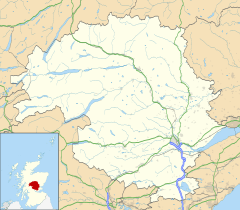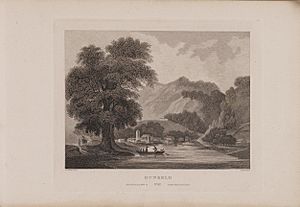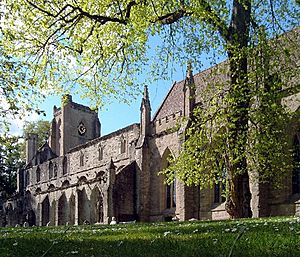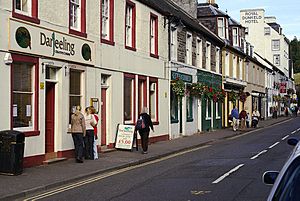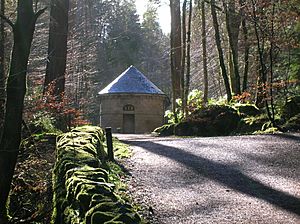Dunkeld facts for kids
Quick facts for kids Dunkeld
|
|
|---|---|
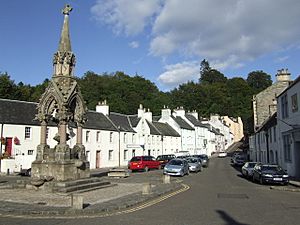 Dunkeld Market Place and fountain |
|
| Population | 1,287 |
| OS grid reference | NO027425 |
| • Edinburgh | 45 mi (72 km) |
| • London | 376 mi (605 km) |
| Council area | |
| Lieutenancy area | |
| Country | Scotland |
| Sovereign state | United Kingdom |
| Post town | DUNKELD |
| Postcode district | PH8 |
| Dialling code | 01350 |
| Police | Tayside |
| Fire | Tayside |
| Ambulance | Scottish |
| EU Parliament | Scotland |
| UK Parliament |
|
| Scottish Parliament |
|
Dunkeld is a small town in Perth and Kinross, Scotland. Its name comes from a Scottish Gaelic phrase meaning "fort of the Caledonians". It is a historic place with a famous cathedral.
Dunkeld sits on the north side of the River Tay, across from the village of Birnam. It is often called the "Gateway to the Highlands." This is because it is located near the Highland Boundary Fault. This fault is a major geological line that separates the Scottish Highlands from the Lowlands.
The town has a railway station called Dunkeld & Birnam. It is on the Highland Main Line. Dunkeld is about 24 kilometers (15 miles) north of Perth. The main A9 road used to go through the town. Now, it passes to the west of Dunkeld.
Dunkeld is known for its well-preserved buildings. Many houses from the late 1600s and early 1700s still stand. The National Trust for Scotland has helped restore about 20 of these homes. They also run a shop in the town. The Hermitage is a beautiful countryside area. It is also managed by the National Trust for Scotland.
A bridge connects Dunkeld with Birnam. The current bridge was designed by Thomas Telford. It was finished in 1809.
Contents
Exploring Dunkeld's Past
How Did Dunkeld Get Its Name?
The name Dùn Chailleann means "Fort of the Caledonii." The Caledonii were an ancient group of people in Scotland. The "fort" likely refers to a hill fort on King's Seat, a hill north of the town. This suggests the area was important even in the Iron Age.
Early Beginnings of Dunkeld
Dunkeld is believed to have been "founded" by Caustantín son of Fergus. He was a king of the Picts who died in 820. This founding probably meant setting up a church. A Pictish monastery was already there.
Kenneth I of Scotland (843–858) brought relics of St Columba to Dunkeld in 849. He did this to protect them from Viking raids. He built a new church for these important items. The relics were split between Dunkeld and another monastery in Kells, Ireland.
An old stone carving called the 'Apostles' Stone' might be from this time. It is now in the cathedral museum. A bronze "Celtic" hand bell may also be from the early monastery.
Dunkeld in the Middle Ages
The church in Dunkeld became very important. For a while, it was the main church site in eastern Scotland. Later, St Andrews took over this role. In 865, a "chief bishop" of Fortriu and Abbot of Dunkeld died. This shows how important the monastery was.
Viking raiders attacked the monastery in 903. But it continued to grow. An abbot named Crínán of Dunkeld (died 1045) married a daughter of King Máel Coluim. Their son, Donnchad (King Duncan I), became a King of Scots.
The Dunkeld Cathedral was rebuilt over many years. The choir, still used as a church, dates from the 1200s and 1300s. The main part of the church (nave) was built in the 1400s. The western tower and other parts were added later.
After the Scottish Reformation in the 1500s, the cathedral lost many of its decorations. The nave and porch have been without roofs since the 1600s. Today, Historic Environment Scotland cares for these parts.
Inside the tower, you can still see parts of old paintings from around 1490. One shows the Judgement of Solomon. This area was once used as the Bishop's Court. The tower also holds old stone pieces. These include a Pictish carving of a horseman.
The cathedral museum is in the old chapter house. After the Reformation, this room was used for burials by the Dukes of Atholl. The museum has old Christian cross-slabs and other items. In 2005, some items were stolen from the museum.
The Battle of Dunkeld (1689)
Most of Dunkeld was destroyed during the Battle of Dunkeld in August 1689. The Cameronian Regiment fought against the Jacobites. The Jacobites had just won a battle at Killiecrankie. You can still see holes from musket balls in the east wall of the cathedral.
Modern Changes in Dunkeld
The town's layout changed a lot in 1809. This was when Thomas Telford built a new stone bridge over the River Tay. A new street (Bridge Street–Atholl Street) was also created. This street still looks very Georgian. It was part of the main road to Inverness until 1977. That's when the A9 bypass was built around Dunkeld and Birnam.
What Does Dunkeld Look Like Today?
Dunkeld is one of Scotland's most complete 18th-century country towns. Many of its traditional buildings have been restored by the National Trust for Scotland (NTS). The older part of town has a 'Y-shaped' street layout. The main street (Brae Street/High Street) slopes down into the market place, called The Cross.
Small lanes, called closes, lead off the main street. These give access to the back areas of the houses. In the market cross area, you'll find the Atholl Memorial Fountain. This fancy fountain was built in 1866. It honors George Murray, 6th Duke of Atholl. The fountain has interesting symbols, including Masonic ones.
At the west end of The Cross is the Ell Shop (NTS). It was built in 1757. Its name comes from an iron "ell" (a old measurement for cloth) fixed to its corner. This building might be on the site of the town's old hospital.
Nearby is the Duchess of Atholl Girls' School. It was built in 1853. It is often called the Duchess Anne School. This is after its founder, Anne Home-Drummond. She was the wife of the 6th Duke of Atholl. Today, the building is used for exhibitions, like the Dunkeld Art Exhibition.
One arm of the 'Y' leads to the medieval cathedral. The area around the cathedral was the first place people settled in Dunkeld. The Bishop's Palace was also located here.
Exploring the Countryside Around Dunkeld
Dunkeld is in an area of Scotland known as Big Tree Country. The area has many trees, including some very famous ones.
- The Birnam Oak: This tree is believed to be the last remaining tree from the Birnam Wood. This wood is mentioned by Shakespeare in his play Macbeth.
- Niel Gow's Oak: This tree is where Niel Gow composed many famous Scottish tunes. He was a fiddler for the Dukes of Atholl.
- The Parent Larch: This is the only survivor from a group of larch trees. They were brought from the Tyrol mountains in 1738. These larches were used to plant many more trees in the area.
Much of the countryside around Dunkeld is a national scenic area. These areas are protected because of their amazing scenery. The River Tay (Dunkeld) National Scenic Area covers a large space. Parts of the area are also part of the Tay Forest Park. This park has many forests managed by Forestry and Land Scotland.
About 3 kilometers (2 miles) northeast of town is the Loch of the Lowes nature reserve. The Scottish Wildlife Trust manages this reserve.
There are many great walks in the area. You can easily climb Birnam Hill. It is 404 meters (1,325 feet) high. It is about 1.5 kilometers (1 mile) south of the railway station.
Ossian's Hall of Mirrors is a special building. It is located in The Hermitage. This area has lovely walks in the woods near the River Braan. The National Trust for Scotland owns this site.
Getting to Dunkeld
The A9 bypass around Dunkeld was built in 1977. Now, Dunkeld is about an hour's drive from Glasgow and Edinburgh. It is two hours from Inverness.
You can also get to Dunkeld by bus or coach. Scottish Citylink operates long-distance coaches.
The town has a train station, Dunkeld & Birnam railway station. It is on the Highland Main Line. This route connects Perth and Inverness. Most trains go to Edinburgh Waverley or Glasgow Queen Street. There is also an overnight train, the Caledonian Sleeper. It travels to and from London Euston.
Images for kids
See also
 In Spanish: Dunkeld para niños
In Spanish: Dunkeld para niños


